Taxation Law: Residency Status, Taxable Income, and Negative Gearing
VerifiedAdded on 2023/06/07
|12
|2099
|306
AI Summary
This article provides expert advice on taxation law, covering topics such as residency status, taxable income, and negative gearing. It includes information on taxation rulings, deductions, and potential tax benefits. The article also includes a letter of advice to clients and references to relevant cases and studies.
Contribute Materials
Your contribution can guide someone’s learning journey. Share your
documents today.
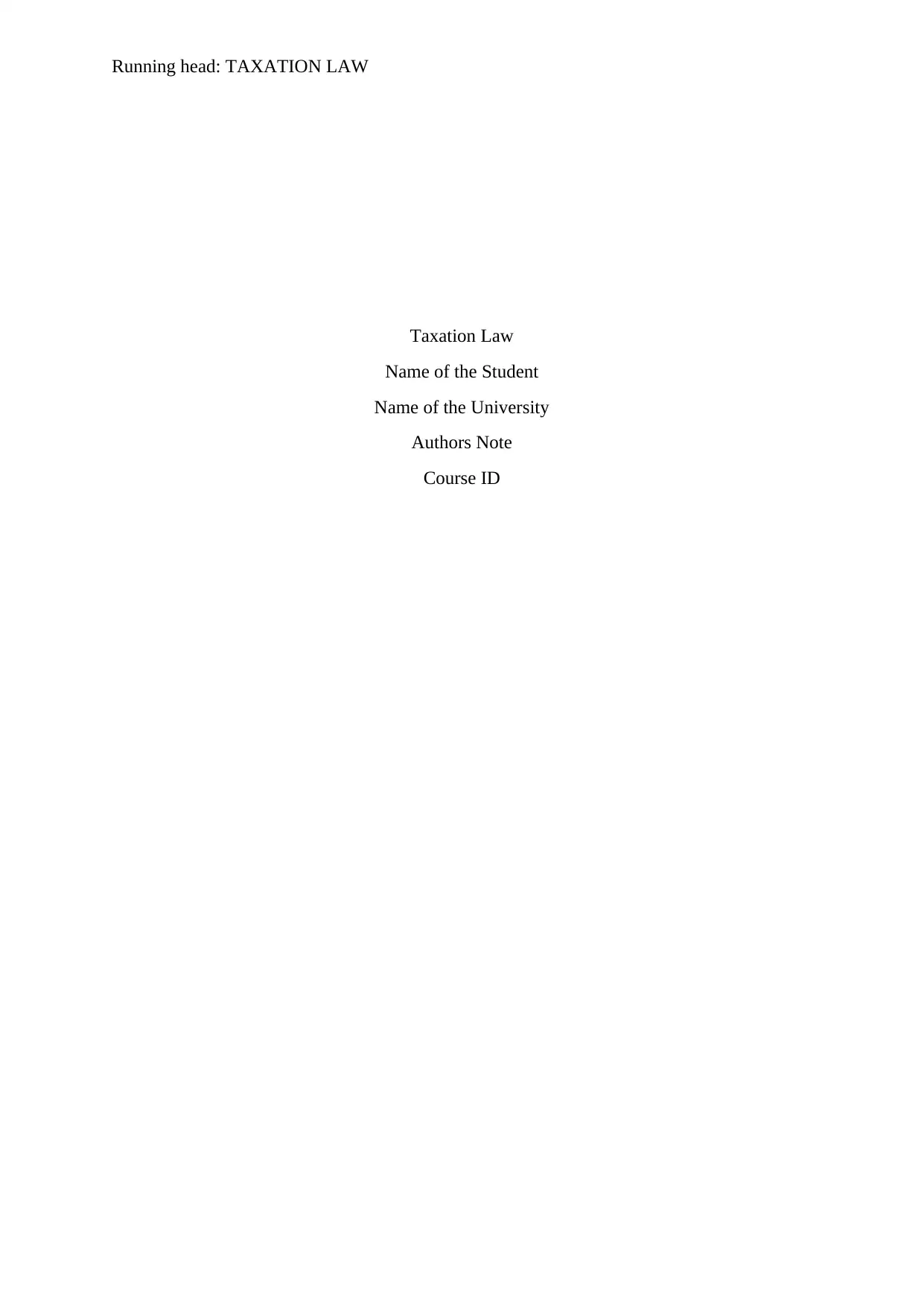
Running head: TAXATION LAW
Taxation Law
Name of the Student
Name of the University
Authors Note
Course ID
Taxation Law
Name of the Student
Name of the University
Authors Note
Course ID
Secure Best Marks with AI Grader
Need help grading? Try our AI Grader for instant feedback on your assignments.
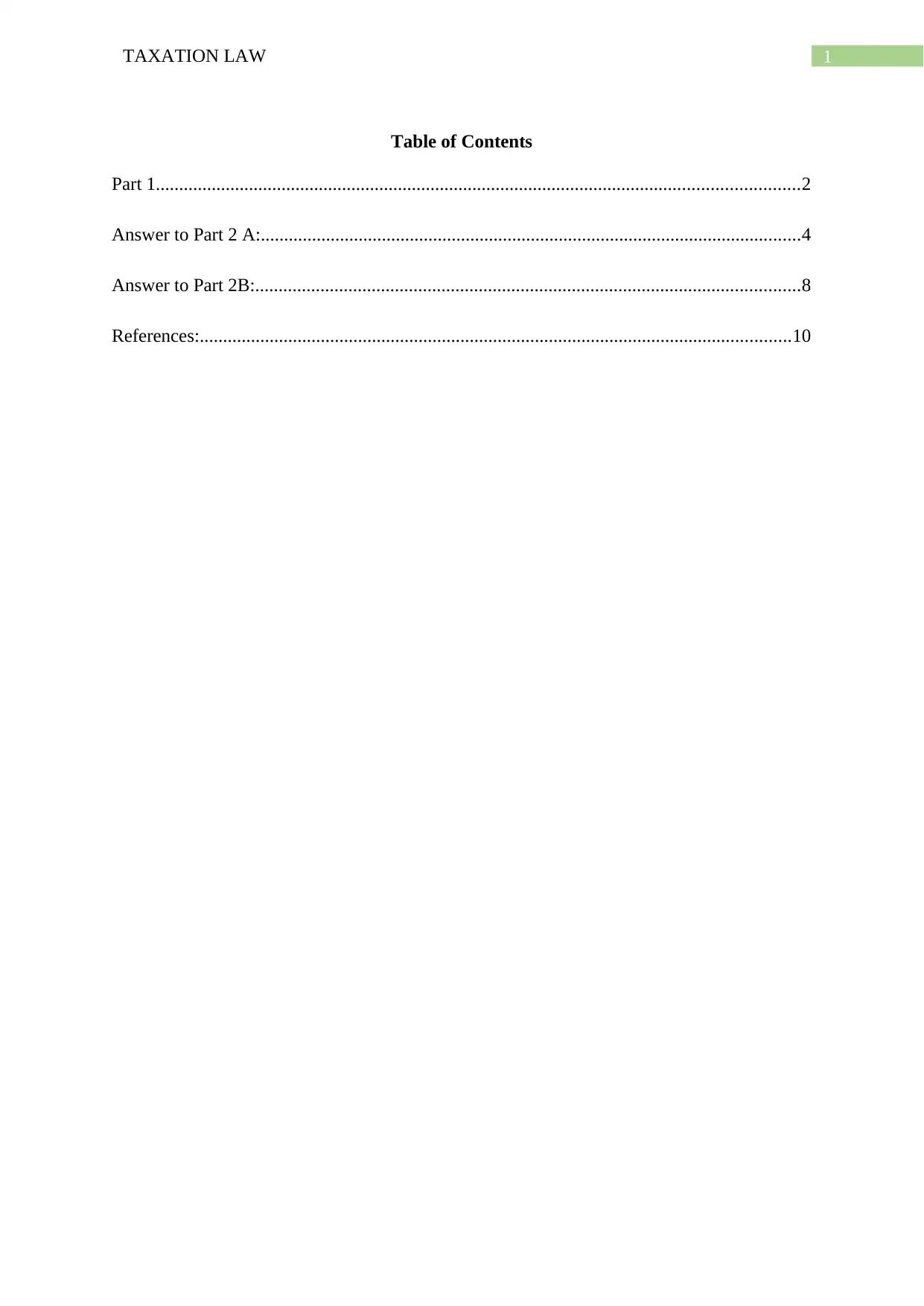
1TAXATION LAW
Table of Contents
Part 1..........................................................................................................................................2
Answer to Part 2 A:....................................................................................................................4
Answer to Part 2B:.....................................................................................................................8
References:...............................................................................................................................10
Table of Contents
Part 1..........................................................................................................................................2
Answer to Part 2 A:....................................................................................................................4
Answer to Part 2B:.....................................................................................................................8
References:...............................................................................................................................10
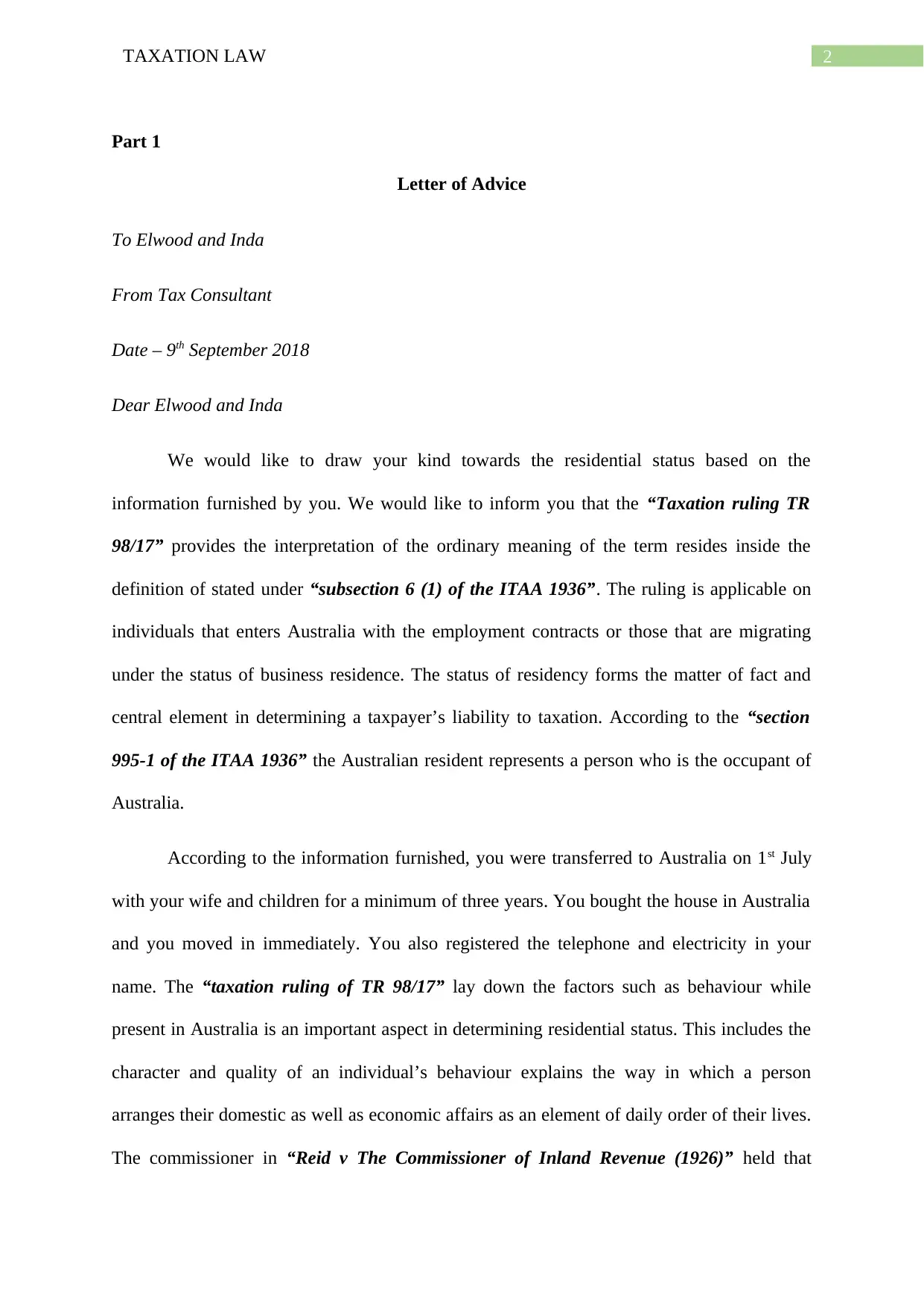
2TAXATION LAW
Part 1
Letter of Advice
To Elwood and Inda
From Tax Consultant
Date – 9th September 2018
Dear Elwood and Inda
We would like to draw your kind towards the residential status based on the
information furnished by you. We would like to inform you that the “Taxation ruling TR
98/17” provides the interpretation of the ordinary meaning of the term resides inside the
definition of stated under “subsection 6 (1) of the ITAA 1936”. The ruling is applicable on
individuals that enters Australia with the employment contracts or those that are migrating
under the status of business residence. The status of residency forms the matter of fact and
central element in determining a taxpayer’s liability to taxation. According to the “section
995-1 of the ITAA 1936” the Australian resident represents a person who is the occupant of
Australia.
According to the information furnished, you were transferred to Australia on 1st July
with your wife and children for a minimum of three years. You bought the house in Australia
and you moved in immediately. You also registered the telephone and electricity in your
name. The “taxation ruling of TR 98/17” lay down the factors such as behaviour while
present in Australia is an important aspect in determining residential status. This includes the
character and quality of an individual’s behaviour explains the way in which a person
arranges their domestic as well as economic affairs as an element of daily order of their lives.
The commissioner in “Reid v The Commissioner of Inland Revenue (1926)” held that
Part 1
Letter of Advice
To Elwood and Inda
From Tax Consultant
Date – 9th September 2018
Dear Elwood and Inda
We would like to draw your kind towards the residential status based on the
information furnished by you. We would like to inform you that the “Taxation ruling TR
98/17” provides the interpretation of the ordinary meaning of the term resides inside the
definition of stated under “subsection 6 (1) of the ITAA 1936”. The ruling is applicable on
individuals that enters Australia with the employment contracts or those that are migrating
under the status of business residence. The status of residency forms the matter of fact and
central element in determining a taxpayer’s liability to taxation. According to the “section
995-1 of the ITAA 1936” the Australian resident represents a person who is the occupant of
Australia.
According to the information furnished, you were transferred to Australia on 1st July
with your wife and children for a minimum of three years. You bought the house in Australia
and you moved in immediately. You also registered the telephone and electricity in your
name. The “taxation ruling of TR 98/17” lay down the factors such as behaviour while
present in Australia is an important aspect in determining residential status. This includes the
character and quality of an individual’s behaviour explains the way in which a person
arranges their domestic as well as economic affairs as an element of daily order of their lives.
The commissioner in “Reid v The Commissioner of Inland Revenue (1926)” held that
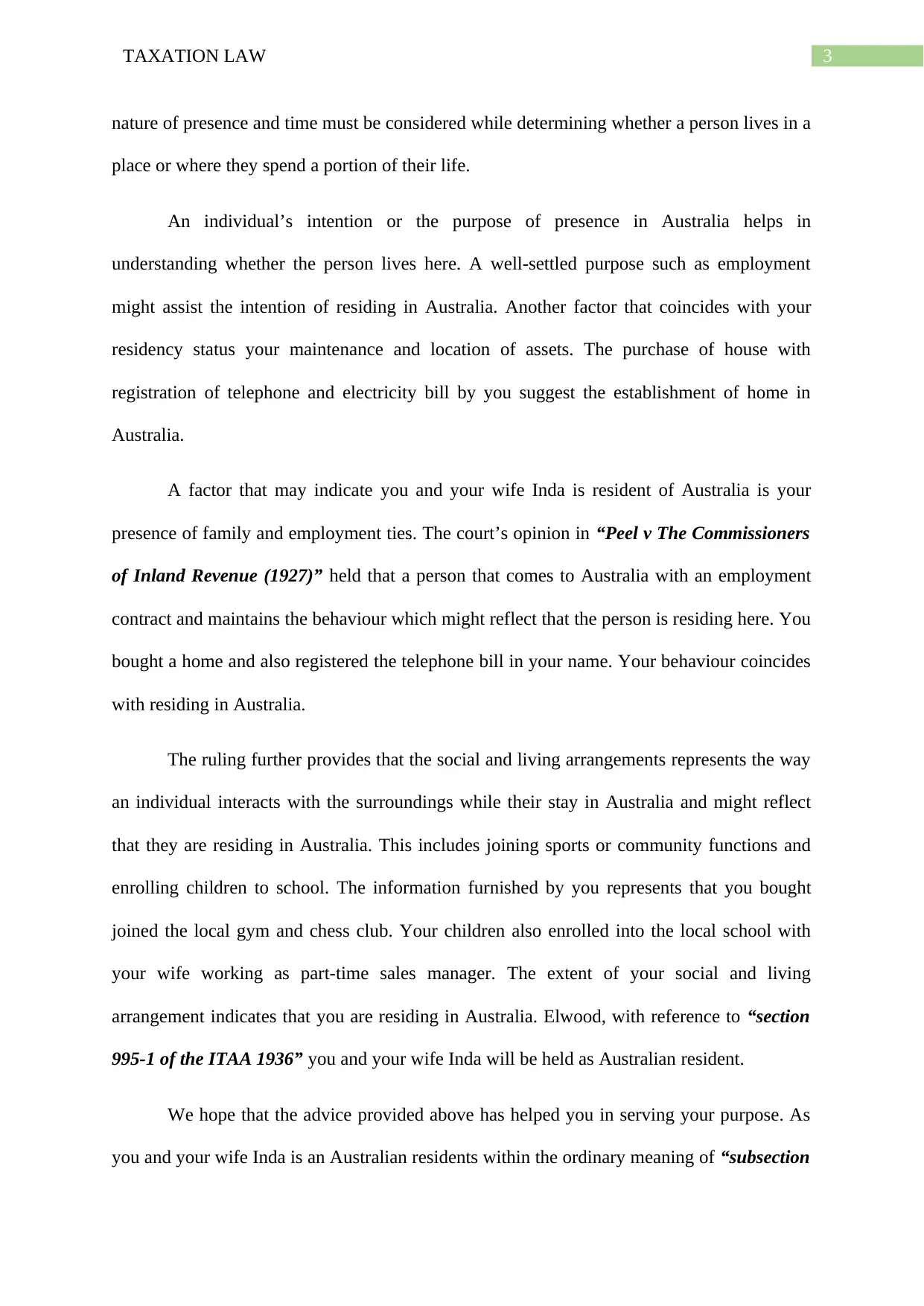
3TAXATION LAW
nature of presence and time must be considered while determining whether a person lives in a
place or where they spend a portion of their life.
An individual’s intention or the purpose of presence in Australia helps in
understanding whether the person lives here. A well-settled purpose such as employment
might assist the intention of residing in Australia. Another factor that coincides with your
residency status your maintenance and location of assets. The purchase of house with
registration of telephone and electricity bill by you suggest the establishment of home in
Australia.
A factor that may indicate you and your wife Inda is resident of Australia is your
presence of family and employment ties. The court’s opinion in “Peel v The Commissioners
of Inland Revenue (1927)” held that a person that comes to Australia with an employment
contract and maintains the behaviour which might reflect that the person is residing here. You
bought a home and also registered the telephone bill in your name. Your behaviour coincides
with residing in Australia.
The ruling further provides that the social and living arrangements represents the way
an individual interacts with the surroundings while their stay in Australia and might reflect
that they are residing in Australia. This includes joining sports or community functions and
enrolling children to school. The information furnished by you represents that you bought
joined the local gym and chess club. Your children also enrolled into the local school with
your wife working as part-time sales manager. The extent of your social and living
arrangement indicates that you are residing in Australia. Elwood, with reference to “section
995-1 of the ITAA 1936” you and your wife Inda will be held as Australian resident.
We hope that the advice provided above has helped you in serving your purpose. As
you and your wife Inda is an Australian residents within the ordinary meaning of “subsection
nature of presence and time must be considered while determining whether a person lives in a
place or where they spend a portion of their life.
An individual’s intention or the purpose of presence in Australia helps in
understanding whether the person lives here. A well-settled purpose such as employment
might assist the intention of residing in Australia. Another factor that coincides with your
residency status your maintenance and location of assets. The purchase of house with
registration of telephone and electricity bill by you suggest the establishment of home in
Australia.
A factor that may indicate you and your wife Inda is resident of Australia is your
presence of family and employment ties. The court’s opinion in “Peel v The Commissioners
of Inland Revenue (1927)” held that a person that comes to Australia with an employment
contract and maintains the behaviour which might reflect that the person is residing here. You
bought a home and also registered the telephone bill in your name. Your behaviour coincides
with residing in Australia.
The ruling further provides that the social and living arrangements represents the way
an individual interacts with the surroundings while their stay in Australia and might reflect
that they are residing in Australia. This includes joining sports or community functions and
enrolling children to school. The information furnished by you represents that you bought
joined the local gym and chess club. Your children also enrolled into the local school with
your wife working as part-time sales manager. The extent of your social and living
arrangement indicates that you are residing in Australia. Elwood, with reference to “section
995-1 of the ITAA 1936” you and your wife Inda will be held as Australian resident.
We hope that the advice provided above has helped you in serving your purpose. As
you and your wife Inda is an Australian residents within the ordinary meaning of “subsection
Secure Best Marks with AI Grader
Need help grading? Try our AI Grader for instant feedback on your assignments.
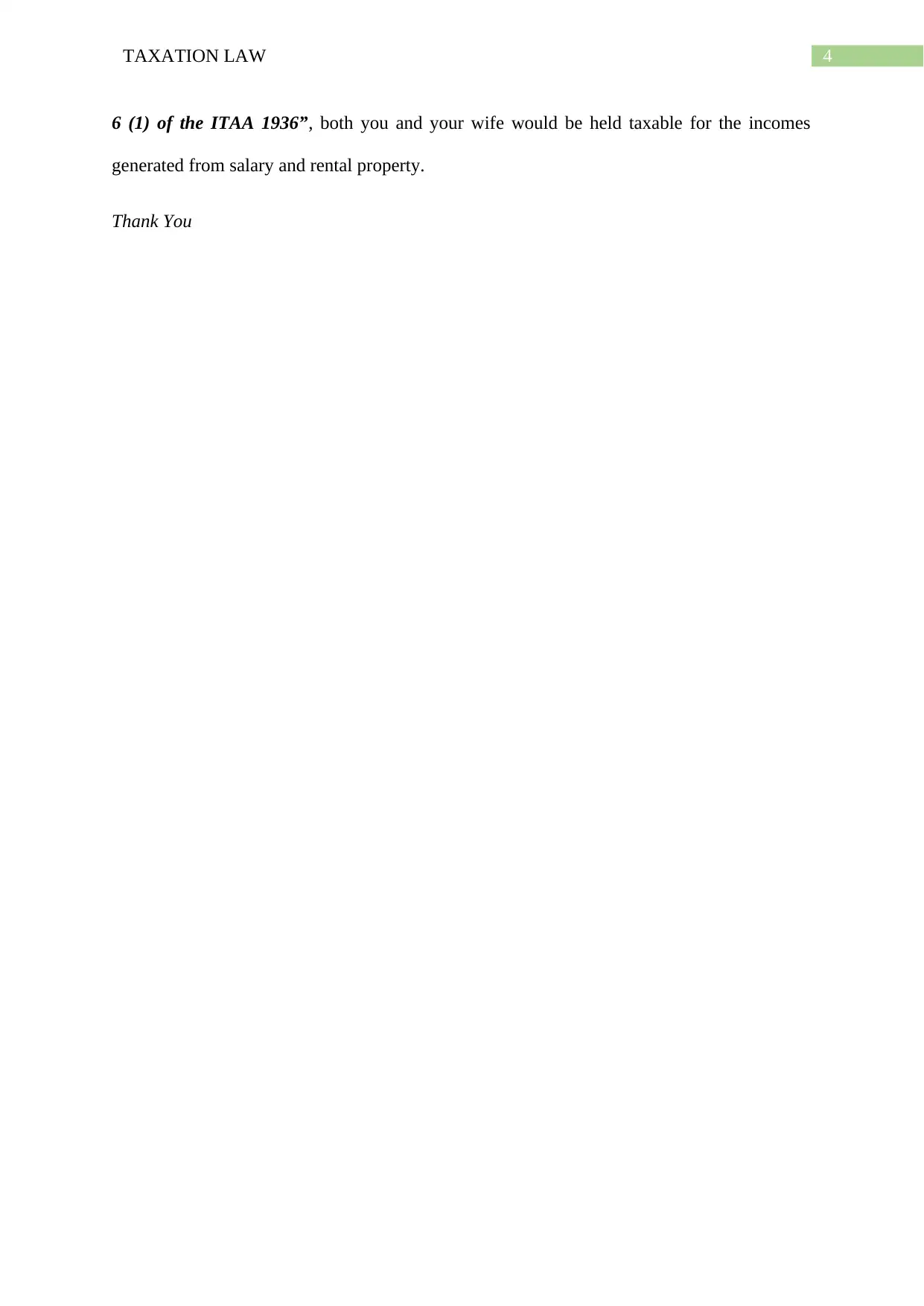
4TAXATION LAW
6 (1) of the ITAA 1936”, both you and your wife would be held taxable for the incomes
generated from salary and rental property.
Thank You
6 (1) of the ITAA 1936”, both you and your wife would be held taxable for the incomes
generated from salary and rental property.
Thank You
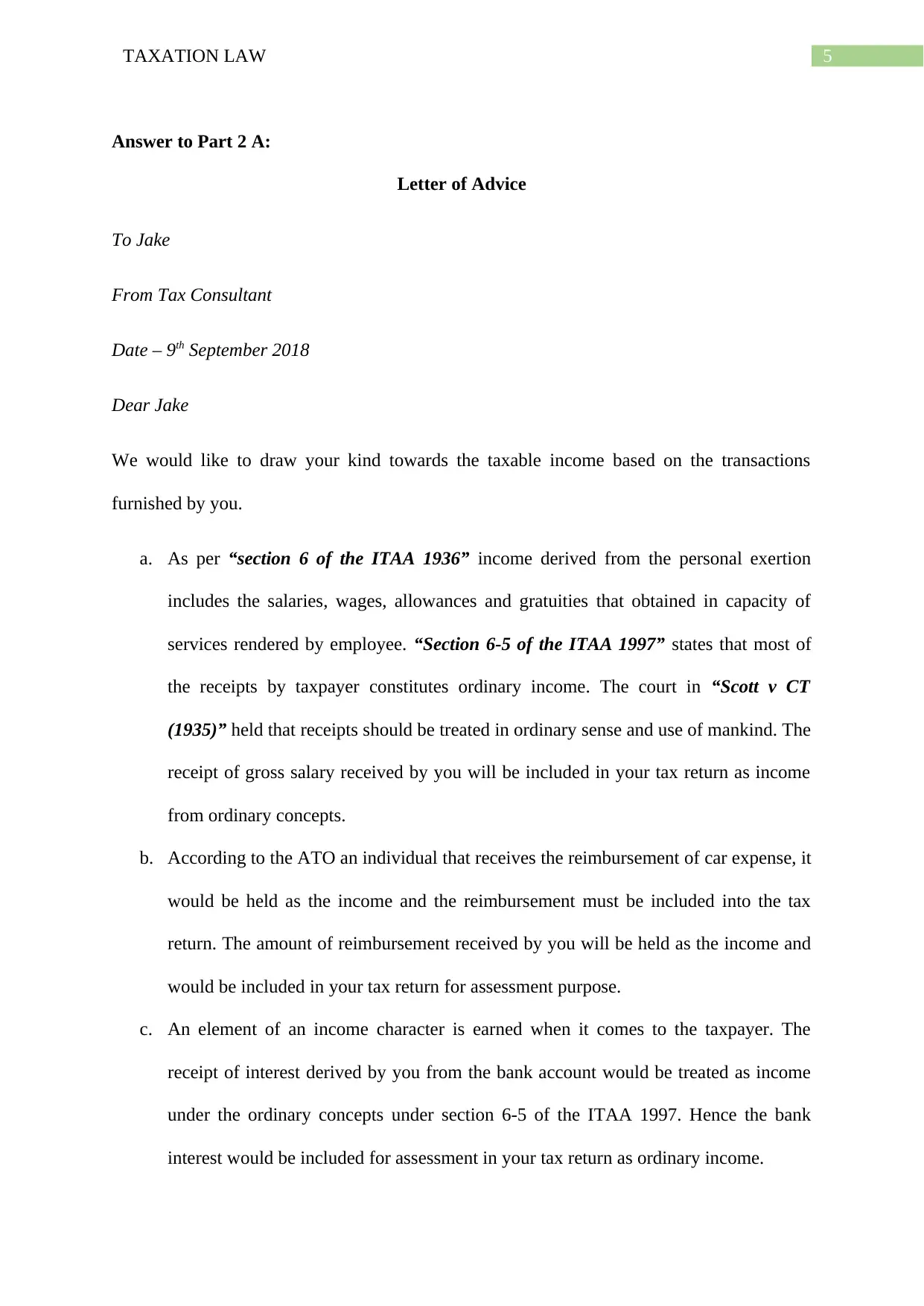
5TAXATION LAW
Answer to Part 2 A:
Letter of Advice
To Jake
From Tax Consultant
Date – 9th September 2018
Dear Jake
We would like to draw your kind towards the taxable income based on the transactions
furnished by you.
a. As per “section 6 of the ITAA 1936” income derived from the personal exertion
includes the salaries, wages, allowances and gratuities that obtained in capacity of
services rendered by employee. “Section 6-5 of the ITAA 1997” states that most of
the receipts by taxpayer constitutes ordinary income. The court in “Scott v CT
(1935)” held that receipts should be treated in ordinary sense and use of mankind. The
receipt of gross salary received by you will be included in your tax return as income
from ordinary concepts.
b. According to the ATO an individual that receives the reimbursement of car expense, it
would be held as the income and the reimbursement must be included into the tax
return. The amount of reimbursement received by you will be held as the income and
would be included in your tax return for assessment purpose.
c. An element of an income character is earned when it comes to the taxpayer. The
receipt of interest derived by you from the bank account would be treated as income
under the ordinary concepts under section 6-5 of the ITAA 1997. Hence the bank
interest would be included for assessment in your tax return as ordinary income.
Answer to Part 2 A:
Letter of Advice
To Jake
From Tax Consultant
Date – 9th September 2018
Dear Jake
We would like to draw your kind towards the taxable income based on the transactions
furnished by you.
a. As per “section 6 of the ITAA 1936” income derived from the personal exertion
includes the salaries, wages, allowances and gratuities that obtained in capacity of
services rendered by employee. “Section 6-5 of the ITAA 1997” states that most of
the receipts by taxpayer constitutes ordinary income. The court in “Scott v CT
(1935)” held that receipts should be treated in ordinary sense and use of mankind. The
receipt of gross salary received by you will be included in your tax return as income
from ordinary concepts.
b. According to the ATO an individual that receives the reimbursement of car expense, it
would be held as the income and the reimbursement must be included into the tax
return. The amount of reimbursement received by you will be held as the income and
would be included in your tax return for assessment purpose.
c. An element of an income character is earned when it comes to the taxpayer. The
receipt of interest derived by you from the bank account would be treated as income
under the ordinary concepts under section 6-5 of the ITAA 1997. Hence the bank
interest would be included for assessment in your tax return as ordinary income.

6TAXATION LAW
d. “Section 6(1) of the ITAA 1936” states an Australian resident company might pay or
credit you with the un-franked dividend. These un-franked dividend does not has any
franking credit attached to it. Therefore, “under section 44 (1) of the ITAA 1936” the
un-franked dividend received by you should be declared in your tax statement for
assessment.
e. “A CGT event G1” happens when capital gains is reported from the sale of shares.
The cost base of the shares would also include the brokerage costs incurred by you.
As evident you reported capital gains from the sale of shares. The capital gains from
the sale of shares would be included in your tax return for assessment purpose as
ordinary income.
f. According to “subdivision 108-C” personal use assets is treated as the non-collectable
assets that is mainly used for the personal enjoyment. According to “section 118-
10(3)” any capital gains or loss made from the personal use asset should be
disregarded that has the cost base of $10,000. Loss made from the sale of autographed
cricket bats yielded a loss for you and hence the same should be disregarded.
g. According to the ATO an individual is allowed to claim motor vehicle expenses for
the portion of the use that is in the direction of business use. You reported a total
travel of 7,420 kilometres out of which 95% were dedicated towards business
purpose. As you have failed to maintain a log book your deductions would be limited
to 5000 kilometres based on standard rate of 66 cents per kilometre.
h. According to the “section 8-1 of the ITAA 1997” allows a taxpayer to claim
deductions for expenses incurred for work purpose. As you have reported a telephone
cost costs of $1,400 you will entitled to claim deductions for 60% of the telephone bill
since the proportion of 60% was related to your work purpose.
d. “Section 6(1) of the ITAA 1936” states an Australian resident company might pay or
credit you with the un-franked dividend. These un-franked dividend does not has any
franking credit attached to it. Therefore, “under section 44 (1) of the ITAA 1936” the
un-franked dividend received by you should be declared in your tax statement for
assessment.
e. “A CGT event G1” happens when capital gains is reported from the sale of shares.
The cost base of the shares would also include the brokerage costs incurred by you.
As evident you reported capital gains from the sale of shares. The capital gains from
the sale of shares would be included in your tax return for assessment purpose as
ordinary income.
f. According to “subdivision 108-C” personal use assets is treated as the non-collectable
assets that is mainly used for the personal enjoyment. According to “section 118-
10(3)” any capital gains or loss made from the personal use asset should be
disregarded that has the cost base of $10,000. Loss made from the sale of autographed
cricket bats yielded a loss for you and hence the same should be disregarded.
g. According to the ATO an individual is allowed to claim motor vehicle expenses for
the portion of the use that is in the direction of business use. You reported a total
travel of 7,420 kilometres out of which 95% were dedicated towards business
purpose. As you have failed to maintain a log book your deductions would be limited
to 5000 kilometres based on standard rate of 66 cents per kilometre.
h. According to the “section 8-1 of the ITAA 1997” allows a taxpayer to claim
deductions for expenses incurred for work purpose. As you have reported a telephone
cost costs of $1,400 you will entitled to claim deductions for 60% of the telephone bill
since the proportion of 60% was related to your work purpose.
Paraphrase This Document
Need a fresh take? Get an instant paraphrase of this document with our AI Paraphraser
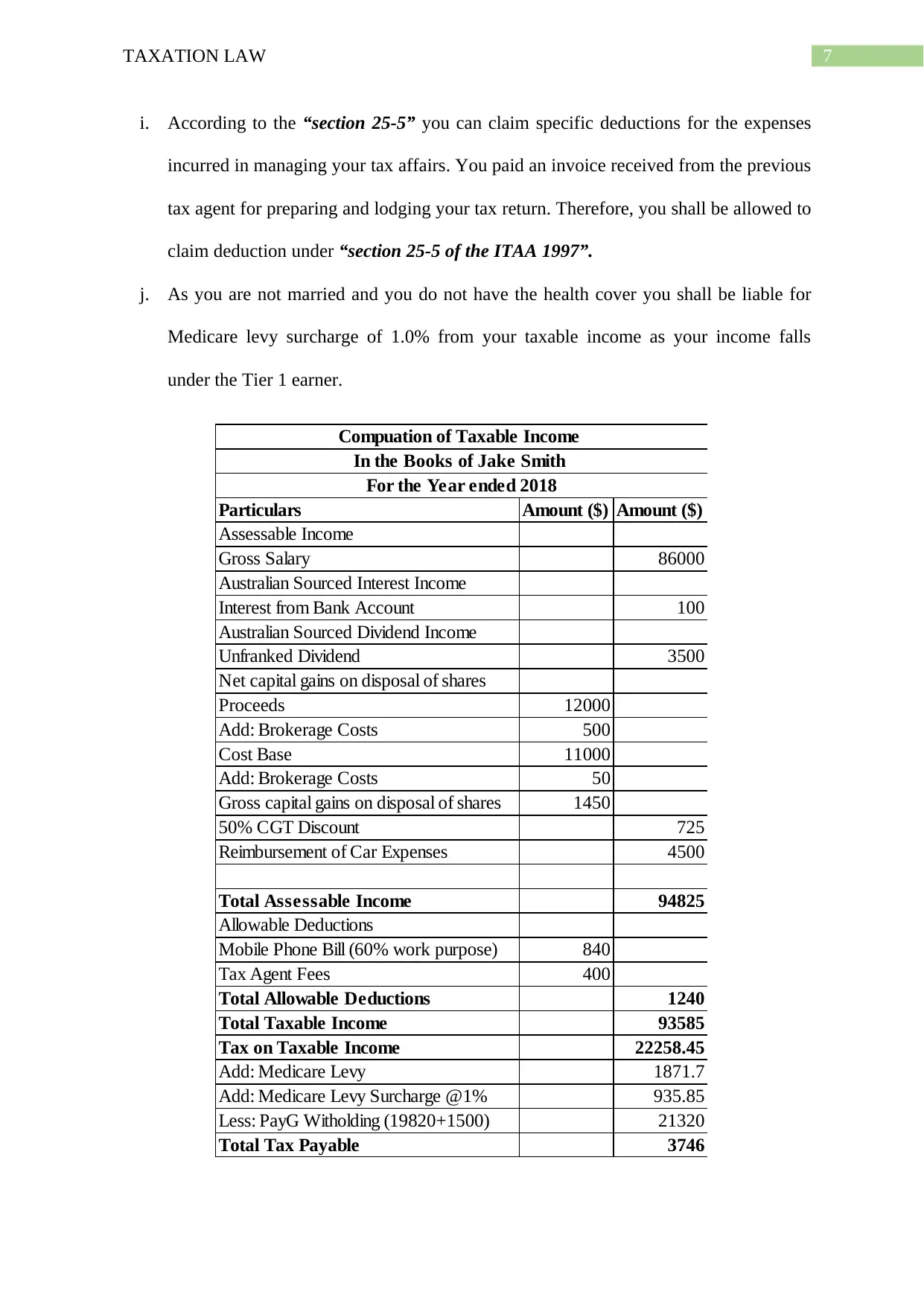
7TAXATION LAW
i. According to the “section 25-5” you can claim specific deductions for the expenses
incurred in managing your tax affairs. You paid an invoice received from the previous
tax agent for preparing and lodging your tax return. Therefore, you shall be allowed to
claim deduction under “section 25-5 of the ITAA 1997”.
j. As you are not married and you do not have the health cover you shall be liable for
Medicare levy surcharge of 1.0% from your taxable income as your income falls
under the Tier 1 earner.
Particulars Amount ($) Amount ($)
Assessable Income
Gross Salary 86000
Australian Sourced Interest Income
Interest from Bank Account 100
Australian Sourced Dividend Income
Unfranked Dividend 3500
Net capital gains on disposal of shares
Proceeds 12000
Add: Brokerage Costs 500
Cost Base 11000
Add: Brokerage Costs 50
Gross capital gains on disposal of shares 1450
50% CGT Discount 725
Reimbursement of Car Expenses 4500
Total Assessable Income 94825
Allowable Deductions
Mobile Phone Bill (60% work purpose) 840
Tax Agent Fees 400
Total Allowable Deductions 1240
Total Taxable Income 93585
Tax on Taxable Income 22258.45
Add: Medicare Levy 1871.7
Add: Medicare Levy Surcharge @1% 935.85
Less: PayG Witholding (19820+1500) 21320
Total Tax Payable 3746
Compuation of Taxable Income
In the Books of Jake Smith
For the Year ended 2018
i. According to the “section 25-5” you can claim specific deductions for the expenses
incurred in managing your tax affairs. You paid an invoice received from the previous
tax agent for preparing and lodging your tax return. Therefore, you shall be allowed to
claim deduction under “section 25-5 of the ITAA 1997”.
j. As you are not married and you do not have the health cover you shall be liable for
Medicare levy surcharge of 1.0% from your taxable income as your income falls
under the Tier 1 earner.
Particulars Amount ($) Amount ($)
Assessable Income
Gross Salary 86000
Australian Sourced Interest Income
Interest from Bank Account 100
Australian Sourced Dividend Income
Unfranked Dividend 3500
Net capital gains on disposal of shares
Proceeds 12000
Add: Brokerage Costs 500
Cost Base 11000
Add: Brokerage Costs 50
Gross capital gains on disposal of shares 1450
50% CGT Discount 725
Reimbursement of Car Expenses 4500
Total Assessable Income 94825
Allowable Deductions
Mobile Phone Bill (60% work purpose) 840
Tax Agent Fees 400
Total Allowable Deductions 1240
Total Taxable Income 93585
Tax on Taxable Income 22258.45
Add: Medicare Levy 1871.7
Add: Medicare Levy Surcharge @1% 935.85
Less: PayG Witholding (19820+1500) 21320
Total Tax Payable 3746
Compuation of Taxable Income
In the Books of Jake Smith
For the Year ended 2018

8TAXATION LAW
Your total tax liability for the income is attached in the advice. We hope that the letter
has served your purpose and we look forward to serve your again in future.
Thank You
Your total tax liability for the income is attached in the advice. We hope that the letter
has served your purpose and we look forward to serve your again in future.
Thank You
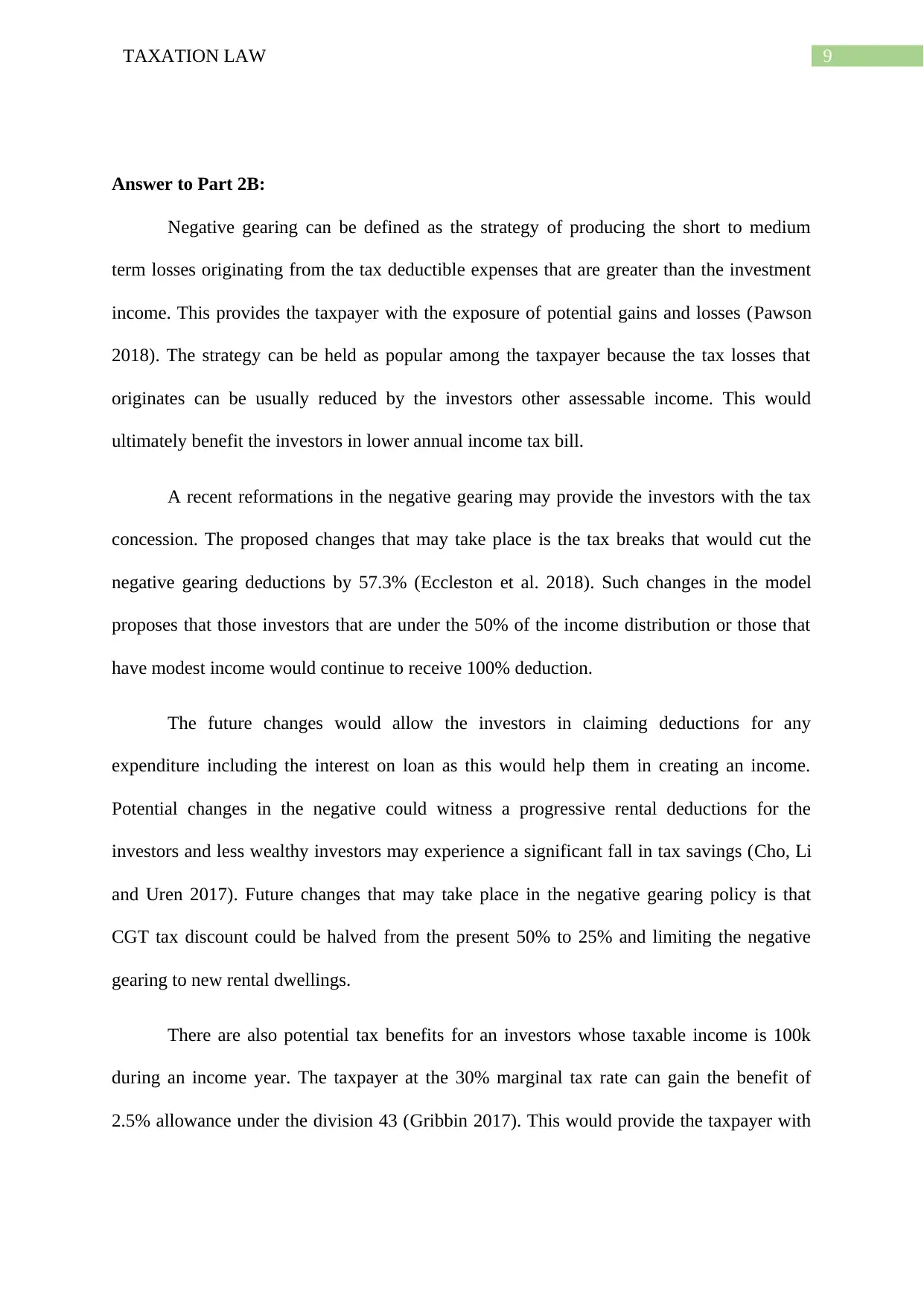
9TAXATION LAW
Answer to Part 2B:
Negative gearing can be defined as the strategy of producing the short to medium
term losses originating from the tax deductible expenses that are greater than the investment
income. This provides the taxpayer with the exposure of potential gains and losses (Pawson
2018). The strategy can be held as popular among the taxpayer because the tax losses that
originates can be usually reduced by the investors other assessable income. This would
ultimately benefit the investors in lower annual income tax bill.
A recent reformations in the negative gearing may provide the investors with the tax
concession. The proposed changes that may take place is the tax breaks that would cut the
negative gearing deductions by 57.3% (Eccleston et al. 2018). Such changes in the model
proposes that those investors that are under the 50% of the income distribution or those that
have modest income would continue to receive 100% deduction.
The future changes would allow the investors in claiming deductions for any
expenditure including the interest on loan as this would help them in creating an income.
Potential changes in the negative could witness a progressive rental deductions for the
investors and less wealthy investors may experience a significant fall in tax savings (Cho, Li
and Uren 2017). Future changes that may take place in the negative gearing policy is that
CGT tax discount could be halved from the present 50% to 25% and limiting the negative
gearing to new rental dwellings.
There are also potential tax benefits for an investors whose taxable income is 100k
during an income year. The taxpayer at the 30% marginal tax rate can gain the benefit of
2.5% allowance under the division 43 (Gribbin 2017). This would provide the taxpayer with
Answer to Part 2B:
Negative gearing can be defined as the strategy of producing the short to medium
term losses originating from the tax deductible expenses that are greater than the investment
income. This provides the taxpayer with the exposure of potential gains and losses (Pawson
2018). The strategy can be held as popular among the taxpayer because the tax losses that
originates can be usually reduced by the investors other assessable income. This would
ultimately benefit the investors in lower annual income tax bill.
A recent reformations in the negative gearing may provide the investors with the tax
concession. The proposed changes that may take place is the tax breaks that would cut the
negative gearing deductions by 57.3% (Eccleston et al. 2018). Such changes in the model
proposes that those investors that are under the 50% of the income distribution or those that
have modest income would continue to receive 100% deduction.
The future changes would allow the investors in claiming deductions for any
expenditure including the interest on loan as this would help them in creating an income.
Potential changes in the negative could witness a progressive rental deductions for the
investors and less wealthy investors may experience a significant fall in tax savings (Cho, Li
and Uren 2017). Future changes that may take place in the negative gearing policy is that
CGT tax discount could be halved from the present 50% to 25% and limiting the negative
gearing to new rental dwellings.
There are also potential tax benefits for an investors whose taxable income is 100k
during an income year. The taxpayer at the 30% marginal tax rate can gain the benefit of
2.5% allowance under the division 43 (Gribbin 2017). This would provide the taxpayer with
Secure Best Marks with AI Grader
Need help grading? Try our AI Grader for instant feedback on your assignments.

10TAXATION LAW
proportionate reduction in cost base resulting in larger assessable capital gains or smaller
capital losses.
proportionate reduction in cost base resulting in larger assessable capital gains or smaller
capital losses.
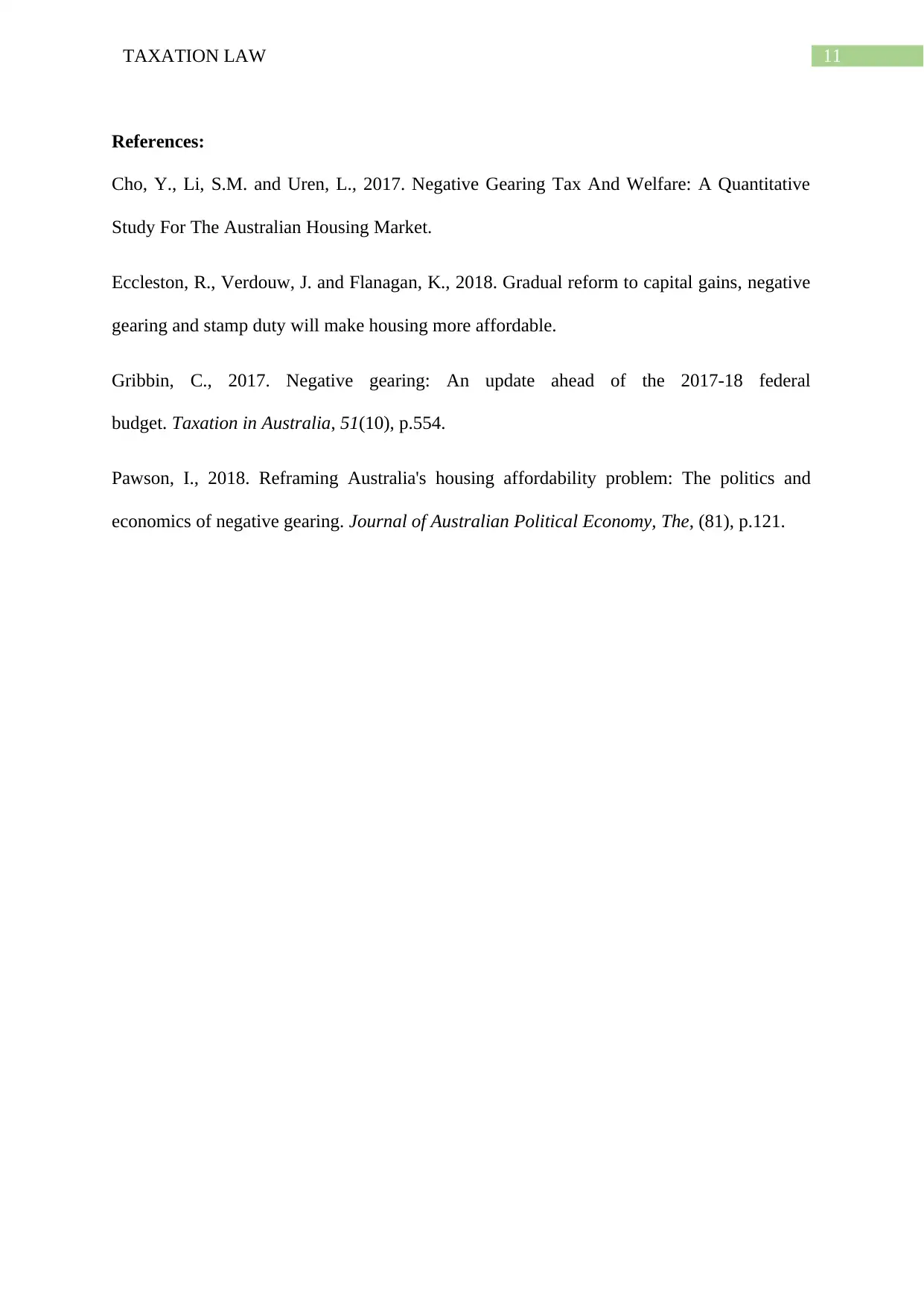
11TAXATION LAW
References:
Cho, Y., Li, S.M. and Uren, L., 2017. Negative Gearing Tax And Welfare: A Quantitative
Study For The Australian Housing Market.
Eccleston, R., Verdouw, J. and Flanagan, K., 2018. Gradual reform to capital gains, negative
gearing and stamp duty will make housing more affordable.
Gribbin, C., 2017. Negative gearing: An update ahead of the 2017-18 federal
budget. Taxation in Australia, 51(10), p.554.
Pawson, I., 2018. Reframing Australia's housing affordability problem: The politics and
economics of negative gearing. Journal of Australian Political Economy, The, (81), p.121.
References:
Cho, Y., Li, S.M. and Uren, L., 2017. Negative Gearing Tax And Welfare: A Quantitative
Study For The Australian Housing Market.
Eccleston, R., Verdouw, J. and Flanagan, K., 2018. Gradual reform to capital gains, negative
gearing and stamp duty will make housing more affordable.
Gribbin, C., 2017. Negative gearing: An update ahead of the 2017-18 federal
budget. Taxation in Australia, 51(10), p.554.
Pawson, I., 2018. Reframing Australia's housing affordability problem: The politics and
economics of negative gearing. Journal of Australian Political Economy, The, (81), p.121.
1 out of 12
Related Documents
Your All-in-One AI-Powered Toolkit for Academic Success.
+13062052269
info@desklib.com
Available 24*7 on WhatsApp / Email
![[object Object]](/_next/static/media/star-bottom.7253800d.svg)
Unlock your academic potential
© 2024 | Zucol Services PVT LTD | All rights reserved.





